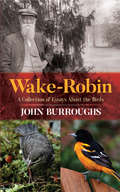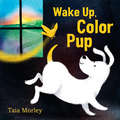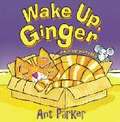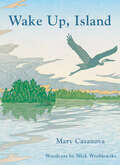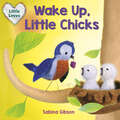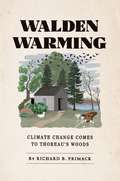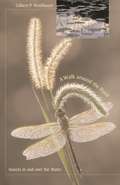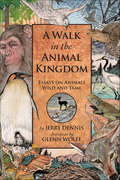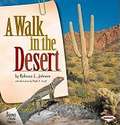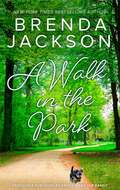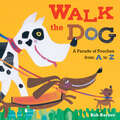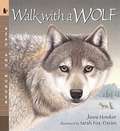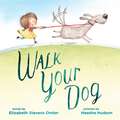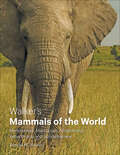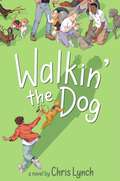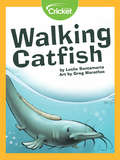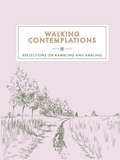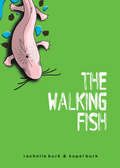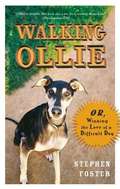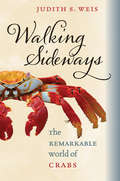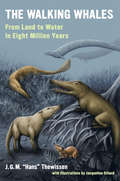- Table View
- List View
Wake-Robin: A Collection of Essays About the Birds
by John BurroughsIn the early spring, the blooming of the wildflower trillium — also known as "wake-robin" — heralds the return of migrating birds. In Wake-Robin: A Collection of Essays About the Birds, John Burroughs offers absorbing reading for birdwatchers, nature lovers, and anyone interested in ecology and conservation. This 1871 collection of essays by the distinguished naturalist showcases his special gift for combining scientific accuracy with a grand poetic expression. These essays particularly focus on birds of the Adirondacks and the Washington, D.C. region."What I offer, in fact, is a careful and conscientious record of actual observations and experiences, and is true as it stands written, every word of it. But what has interested me most in ornithology is the pursuit, the chase, the discovery," he notes, adding that "I have tried to present a live bird, a bird in the woods or the fields, with the atmosphere and associations of the place, and not merely a stuffed and labeled specimen." Although scrupulously factual, Burroughs' investigations are less those of a scientist and more in the nature of an experienced and articulate observer who delights in sharing the timeless joys of birdwatching and the outdoors.
Wake Up, Color Pup
by Taia MorleyA beautiful picture book about a little pup's colorful journey through the range of his emotions!A bright yellow bird promises to bring adventure to sleepy Pup's gray world. As Pup follows his new friend on a walk, each discovery ignites a new feeling and corresponding color, until Pup is saturated with them. But when a storm comes, Pup's color is drained as fear sweeps through him. Only his curious yellow friend remains bright, and encourages him to keep his chin up, play, and carry on! This is a remarkably simple and resonant examination of exploration and resilience, and introduces the idea of abstract association.
Wake Up, Crabby!: An Acorn Book (A Crabby Book #3)
by Jonathan FenskeIt's bedtime for this cranky crab!Pick a book. Grow a Reader!This series is part of Scholastic's early reader line, Acorn, aimed at children who are learning to read. With easy-to-read text, a short-story format, plenty of humor, and full-color artwork on every page, these books will boost reading confidence and fluency. Acorn books plant a love of reading and help readers grow!It's bedtime for Plankton and Crabby! Crabby just wants to go to sleep, but Plankton has other ideas. Plankton wants Crabby to take a bath. Plankton wants Crabby to tell a bedtime story. Will Crabby ever get to go to sleep? With comic speech bubbles and full-color artwork throughout, Geisel Award Honoree Jonathan Fenske's early reader series is sure to be a hit with new readers!
Wake Up, Ginger
by Ant ParkerHe's purr-fect for even the youngest reader! Ginger is enjoying his catnap, until a clever mouse says "Wake Up, Ginger!" and leads him on a chase all over the house. Lift the flaps on every page to watch their hilarious game of cat-and-mouse. Maybe Ginger should just go back to bed!
Wake Up, Island
by Mary CasanovaWake up, little one, a soft voice beckons, the world around you is already stirring. As Wake Up, Island gently rouses the sleepy child, it summons a world of nature coming to life on a summer island in the magical North Woods. Sunlit fingers touch the shores, pine trees stretch their limbs, and lichen warms on ancient rock. Doe and fawn rise from their grass bed and pearls of dew bead a spider&’s finely woven web. Mallards skim the water&’s surface. Ravens perch and gargle greetings, chickadees call dee, dee, dee, and a heron swoops—minnows flee! The moose and her calf wade, munching on plants. The red squirrel chatters. The black bear lazily scratches her back against a tree.Conjuring the morning life around a cabin fragrant with berry pancakes, this timeless book wakens the child in every reader to the wonders of nature that greet every new day in the charmed world of a northern woodland island.
Wake Up, Little Chicks! (Little Loves #1)
by Sabina GibsonJoin chicks, turtles, and their fuzzy countryside friends as they stretch and yawn and start the day in this new board book series!These adorable board books follow a group of fuzzy backyard families as parents guide their babies through daily life. In Wake Up, Chicks!, readers will see mice and insects starting their days while a family of owls is just settling in to sleep. Sabina Gibson's warm and inviting world is perfect for new families to curl up in together. Don't miss the other books in the Little Loves series: Eat Up, Triceratops, Can Tapir Play?, and Sleep Tight, Polar Bear!
Wake Up, Woodlands
by Karen JamesonCelebrate the promise and potential of spring in this effervescent follow-up to Woodland Dreams.Oh, the promise of spring and a new day! A honeybee, bear cub, bunny, squirrel, fawns, and more wake up as the landscape brims and bursts with spring firsts. In this beautifully illustrated picture book follow-up to their beloved bedtime book, Karen Jameson and Marc Boutavant offer a lyrical and reassuring ode to the morning and a celebration of a new season, affirming the power of greeting the day with energy, positivity, and hope.Readers will adore the heartwarming illustrations and tender moments between animal parents and children. Perfect read-aloud to share over breakfast, with a preschool class for morning storytime, or on the first day of spring.STUNNING ILLUSTRATIONS: Marc Boutavant's detail-rich and incredibly sweet illustrations will rivet young readers as they move through spring-infused scenes filled with woodland animals and flowers.SOOTHING NARRATIVE: In addition to reinforcing concepts like emotional security and unconditional love, the lyrical, rhyming text creates a warm and connected reading experience.EDUCATIONAL CHILDREN'S BOOK: Animals featured in their natural habitats offer a great way to learn about and increase our appreciation of nature. Perfect selection as an Earth Day book for kids!CRITICAL ACCLAIM FOR WOODLAND DREAMS: "Jameson displays a rare gift for harmonious language and rhyme. . . . Sweet fare for bed- or naptimes, with a light frosting of natural history." –Kirkus Reviews, starred review; "[A] classic-feeling narrative that features graceful verse and detailed artwork." –Publishers WeeklyPerfect for:Parents, grandparents, and caregivers looking for a sweet springtime book for childrenFans of Woodland Dreams and author Karen Jameson's children's booksFans of Marc Boutavant's picture booksParents looking for a book with meaningful parent-child connectionsGift givers seeking a sweet and engaging present or Easter basket addition
Walden Warming: Climate Change Comes to Thoreau's Woods
by Richard B. PrimackIn his meticulous notes on the natural history of Concord, Massachusetts, Henry David Thoreau records the first open flowers of highbush blueberry on May 11, 1853. If he were to look for the first blueberry flowers in Concord today, mid-May would be too late. In the 160 years since Thoreau’s writings, warming temperatures have pushed blueberry flowering three weeks earlier, and in 2012, following a winter and spring of record-breaking warmth, blueberries began flowering on April 1--six weeks earlier than in Thoreau’s time. The climate around Thoreau’s beloved Walden Pond is changing, with visible ecological consequences. In Walden Warming, Richard B. Primack uses Thoreau and Walden, icons of the conservation movement, to track the effects of a warming climate on Concord’s plants and animals. Under the attentive eyes of Primack, the notes that Thoreau made years ago are transformed from charming observations into scientific data sets. Primack finds that many wildflower species that Thoreau observed--including familiar groups such as irises, asters, and lilies--have declined in abundance or have disappeared from Concord. Primack also describes how warming temperatures have altered other aspects of Thoreau’s Concord, from the dates when ice departs from Walden Pond in late winter, to the arrival of birds in the spring, to the populations of fish, salamanders, and butterflies that live in the woodlands, river meadows, and ponds. Primack demonstrates that climate change is already here, and it is affecting not just Walden Pond but many other places in Concord and the surrounding region. Although we need to continue pressuring our political leaders to take action, Primack urges us each to heed the advice Thoreau offers in Walden: to "live simply and wisely. ” In the process, we can each minimize our own contributions to our warming climate.
A Walk around the Pond: Insects in and over the Water
by Gilbert WaldbauerA water strider darts across a pond, its feet dimpling the surface tension; a giant water bug dives below, carrying his mate’s eggs on his back; hidden among plant roots on the silty bottom, a dragonfly larva stalks unwary minnows. Barely skimming the surface, in the air above the pond, swarm mayflies with diaphanous wings. Take this walk around the pond with Gilbert Waldbauer and discover the most amazingly diverse inhabitants of the freshwater world.In his hallmark companionable style, Waldbauer introduces us to the aquatic insects that have colonized ponds, lakes, streams, and rivers, especially those in North America. Along the way we learn about the diverse forms these arthropods take, as well as their remarkable modes of life—how they have radiated into every imaginable niche in the water environment, and how they cope with the challenges such an environment poses to respiration, vision, thermoregulation, and reproduction. We encounter the caddis fly larva building its protective case and camouflaging it with stream detritus; green darner dragonflies mating midair in an acrobatic wheel formation; ants that have adapted to the tiny water environment within a pitcher plant; and insects whose adaptations to the aquatic lifestyle are furnishing biomaterials engineers with ideas for future applications in industry and consumer goods.While learning about the evolution, natural history, and ecology of these insects, readers also discover more than a little about the scientists who study them.
A Walk in the Animal Kingdom: Essays on Animals Wild and Tame (The Wonders of Nature)
by Jerry DennisAnimals are everywhere in our lives. We follow them into the wild, we invite them into our homes, they inhabit our dreams, mythologies, folklores, and popular cultures. What is this powerful bond? Why are we so fascinated with animals of every kind? And why has our relationship with them always been riddled with such complexity and contradiction?A Walk in the Animal Kingdom explores the world of animals with the inquisitiveness, depth, and gentle humor that readers across the globe have come to expect from the acclaimed author-artist team of Jerry Dennis and Glenn Wolff. The book is an inquiry into animals of the world, their astonishing diversity and abundance; their mating habits, defensive strategies, and other behaviors; their extraordinary senses of sight, hearing, and smell. It is also an exploration of our profound connection with them, from the joys they inspire and the fears they arouse, to their prominence in our lives as pets, team mascots, and embodiments of wild nature—and the paradox that allows us to battle to protect certain species while ignoring others that are disappearing at a rate perhaps unequaled in the history of our planet. Like the previous collaborations of Dennis and Wolff, A Walk in the Animal Kingdom is certain to become a classic among books about nature—its wonders, its complexities, and our place in it.
A Walk In The Desert
by Rebecca L. JohnsonTake a walk through the desert. This hot, dry biome of the southwest is full of life. How do plants and animals of the desert live? As you wander through the desert, discover how each and every plant and animal relies on the others to live and grow.
A Walk in the Park
by Brenda JacksonAn adult hotline operator meets a man straight out of her private fantasies in this classic, must-read story from New York Times bestselling author Brenda Jackson, first published in 2013 as Smookie and the Bandit in the anthology Love Bites. Raquel Capers is shocked to discover that her precious pooch, Smookie, is having puppies with the dog next door. She feels it’s only fair that her neighbor, Quest Newman, help with the expenses from this unexpected development. But what’s even more shocking to Raquel is how attractive she finds Quest, and the sparks are definitely mutual. Will these two go from neighbors to something more thanks to a little help from their four-legged friends?
Walk the Dog: A Parade of Pooches from A to Z
by Bob BarnerThis tail-wagging book features an alphabet of jumping, barking, playing dogs. From Airedales to Zwergpinschers, the 26 breeds gather to form one big, boisterous, barking pack. Bob Barner's colorful collage illustrations and a bouncy, fun-to-read-aloud text make this book a playful introduction to man's (and kid's) best friend.
Walk with a Wolf: Read And Wonder (Read And Wonder)
by Janni HowkerWalk with a wolf . . . as she hunts alone, howls to her pack, and greets her cubs and mate. Hunt with the pack as it follows the scent of a bull moose, crouching and charging. Learn all about these lords of the far north, who have been hunted by man nearly to extinction. With evocative watercolors by Sarah Fox-Davies, Walk with a Wolf is as full of beauty and drama as it is of facts about this mysterious and often maligned creature.
Walk Your Dog
by Elizabeth Stevens OmlorPet lovers will adore this funny romp about the ups and downs of day in the life of a kid and her canine.Walking your dog is easy...but only if your dog wants to walk. This bouncy day-in-the-life adventure shows what happens when you pair a spunky little girl with a dog who's as stubborn as he is furry. Debut author-illustrator team Elizabeth Stevens Omlor and Neesha Hudson use spare text and gorgeous ink-and-watercolor illustrations to show kids that working as a team requires cooperation, patience, and heart.
Walker's Mammals of the World: Monotremes, Marsupials, Afrotherians, Xenarthrans, and Sundatherians
by Ronald M. NowakThe preeminent guide to the world’s mammals is now enhanced with a dramatically expanded volume covering 19 orders, including such creatures as elephants, armadillos, and manatees.Since its first publication in 1964, Walker's Mammals of the World has become a favorite guide to the natural world for general readers and professionals alike. This new Walker's volume is a completely revised and updated compendium of information on five of the earliest clades to diverge from ancient mammal stock. Uniquely comprehensive in inimitable Walker's style, it incorporates a full account of every genus that has lived in the past 5,000 years. Every named species of each genus is listed in systematic order and accompanied by detailed descriptions of past and present range. This new edition includes• 500+ full-color images throughout• citations to more than 2,200 new references• extensive bioconservation data, with discussion of every species in an IUCN Red List threatened categoryThis volume's thorough updates reflect 20 years of advances in our knowledge of taxonomy, ecology, behavior, life history, and conservation. Substantive changes to 100% of previously existing generic accounts, plus the addition of 17 entirely new generic accounts, double the information in the last edition on the 19 orders covered. The black-and-white illustrations of earlier editions have been replaced by over 500 superb new color images. Remaining true to Ernest P. Walker's vision, the text smoothly combines in-depth scholarship with a popular, readable style to preserve and enhance what the Washington Post called a "landmark of zoological literature."
Walkin' the Dog
by Chris Lynch&“Lynch is back and better, smarter, and funnier than ever.&” —Jacqueline Woodson, National Book Award Winner A boy learns how to be a friend from man&’s best friend in this funny and moving middle grade novel about humans being able to change and dogs changing us from acclaimed author Chris Lynch.In a family of strong personalities with very strong points of view, Louis is what his mother lovingly calls &“the inactivist,&” someone who&’d rather kick back than stand out. He only hopes he can stay under the radar when he starts high school in the fall, his first experience with public school after years of homeschooling. But when a favor for a neighbor and his stinky canine companion unexpectedly turns into a bustling dog-walking business, Louis finds himself meeting an unprecedented number of new friends—both human and canine. Agatha, a quippy and cagey girl his age always seems to be telling two truths and a lie. Cyrus, a few years his senior, promises he&’s going to show Louis how to be a better person, whether Louis wants him to or not. And then there are the dogs: misbehaving border terriers, the four (possible stolen) sausage dogs, the rest of Louis&’s charges, and a mysterious white beast who appears at a certain spot at the edge of the woods. Dogs and human alike all seem to have something they want to teach Louis, including his menacing older brother who keeps turning up everywhere. But is Louis ready to learn the lesson he needs most: how to stop being a lone wolf and be part of a pack?
Walking Catfish
by Leslie SantamariaT.J. just moved from New York City to a small town in the country. One day, he sees something incredible, something he would never see in the city—catfish walking on land!
Walking Contemplations: Reflections on Rambling and Ambling
by Trigger Publishing‘All paths lead nowhere, so it is important to choose a path that has heart.' - Carlos Castaneda. This beautifully packaged book offers the reader a rare opportunity to slow down and receive the natural restorative power of nature through a selection of beautiful, evocative quotes transporting the reader to a space of contemplative reflection inspired by the mindful art of walking. ‘Once trodden by human feet, a natural path becomes a work of man, each traveller marking the way for the next, sometimes departing from the most direct or obvious route to avoid a muddy patch, or to keep out of sight of possible enemies. Feet follow foosteps and so a road is trodden in history.’- The Oldest Road, An Exploration of the Ridgeway, JRL Anderson and Fay Godwin
The Walking Fish
by Rachelle Burk Kopel BurkA humorous, exciting tale of an ordinary girl who makes an extraordinary scientific discovery--a blind fish that walksWhen seventh-grader Alexis catches an unusual fish that looks like a living fossil, she sets off a frenzied scientific hunt for more of its kind. Alexis and her friend Darshan join the hunt, snorkeling, sounding the depths of Glacial Lake, even observing from a helicopter and exploring a cave. All the while, they fight to keep the selfish Dr. Mertz from claiming the discovery all for himself. When Alexis follows one final hunch, she risks her life and almost loses her friend. Walking Fish is a scientific adventure that provides a perfect combination of literacy and science.
Walking Ollie: Or, Winning the Love of a Difficult Dog
by Stephen FosterBritain?s answer to Marley and Me?the hilarious and heartwarming international bestseller about learning to live with a troublesome dog. Like many first-time pet owners, London-based novelist Stephen Foster was upbeat as he began his search for a puppy to adopt. How hard can it be to take care of a dog, he thought?read a guidebook or two, buy a few supplies, and get on with it. But all the books and supplies in the world couldn?t have prepared him for life with Ollie, a willful and moody adopted dog who quickly demonstrated his displeasure at the notion of being told what to do. Walking Ollie tells the funny and charming story of how a growling, skittish man and his equally growling, skittish dog broke each other in, came to see eye to eye, and decided to become best friends. .
Walking Sideways: The Remarkable World of Crabs
by Judith S. WeisThe world's nearly 7,000 species of crabs are immediately recognizable by their claws, sideways movement, stalked eyes, and thick outer shells. These common crustaceans are found internationally, thriving in various habitats from the edge of the sea to the depths of the ocean, in fresh water or on land. Despite having the same basic body type as decapod crustaceans-true crabs have heavy exoskeletons and ten limbs with front pincer claws-crabs come in an enormous variety of shapes and sizes, from the near microscopic to the giant Japanese spider crab.In Walking Sideways, Judith S. Weis provides an engaging and informative tour of the remarkable world of crabs, highlighting their unique biology and natural history. She introduces us to recently discovered crabs such as the Yeti crab found in deep sea vents, explains what scientists are learning about blue and hermit crabs commonly found at the shore, and gives us insight into the lifecycles of the king and Dungeness crabs typically seen only on dinner plates. Among the topics Weis covers are the evolution and classification of crabs, their habitats, unique adaptations to water and land, reproduction and development, behavior, ecology, and threats, including up-to-date research.Crabs are of special interest to biologists for their communication behaviors, sexual dimorphism, and use of chemical stimuli and touch receptors, and Weis explains the importance of new scientific discoveries. In addition to the traditional ten-legged crabs, the book also treats those that appear eight-legged, including hermit crabs, king crabs, and sand crabs. Sidebars address topics of special interest, such as the relationship of lobsters to crabs and medical uses of compounds derived from horseshoe crabs (which aren't really crabs). While Weis emphasizes conservation and the threats that crabs face, she also addresses the use of crabs as food (detailing how crabs are caught and cooked) and their commercial value from fisheries and aquaculture. She highlights other interactions between crabs and people, including keeping hermit crabs as pets or studying marine species in the laboratory and field. Reminding us of characters such as The Little Mermaid's Sebastian and Sherman Lagoon's Hawthorne, she also surveys the role of crabs in literature (for both children and adults), film, and television, as well in mythology and astrology. With illustrations that offer delightful visual evidence of crab diversity and their unique behaviors, Walking Sideways will appeal to anyone who has encountered these fascinating animals on the beach, at an aquarium, or in the kitchen.
Walking the Bob (Little Golden Book)
by Victoria SaxonA super-cute Little Golden Book based on the Disney Junior show Puppy Dog Pals!Bingo and Rolly are the cutest pug puppies around. Children ages 2 to 5 will love this Little Golden Book, which retells an episode of the new Disney Junior show Puppy Dog Pals.Puppy Dog Pals is a preschool show that follows two adorable pug puppies, Bingo and Rolly, who find adventure as they travel the world doing whatever it takes to make their owner, Bob, happy.
Walking Thru The Jungle
by Debbie HarterJoin a fearless young explorer as she encounters different animals and terrains of the world and makes it home for supper, safe and sound.
The Walking Whales: From Land to Water in Eight Million Years
by J. G. ThewissenHans Thewissen, a leading researcher in the field of whale paleontology and anatomy, gives a sweeping first-person account of the discoveries that brought to light the early fossil record of whales. As evidenced in the record, whales evolved from herbivorous forest-dwelling ancestors that resembled tiny deer to carnivorous monsters stalking lakes and rivers and to serpentlike denizens of the coast. Thewissen reports on his discoveries in the wilds of India and Pakistan, weaving a narrative that reveals the day-to-day adventures of fossil collection, enriching it with local flavors from South Asian culture and society. The reader senses the excitement of the digs as well as the rigors faced by scientific researchers, for whom each new insight gives rise to even more questions, and for whom at times the logistics of just staying alive may trump all science. In his search for an understanding of how modern whales live their lives, Thewissen also journeys to Japan and Alaska to study whales and wild dolphins. He finds answers to his questions about fossils by studying the anatomy of otters and porpoises and examining whale embryos under the microscope. In the book's final chapter, Thewissen argues for approaching whale evolution with the most powerful tools we have and for combining all the fields of science in pursuit of knowledge.
